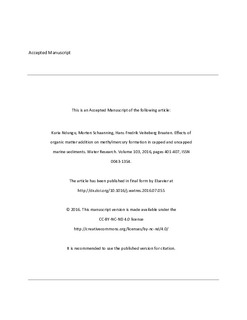| dc.contributor.author | Ndungu, Kuria | |
| dc.contributor.author | Schaanning, Morten | |
| dc.contributor.author | Braaten, Hans Fredrik Veiteberg | |
| dc.date.accessioned | 2018-11-12T07:24:51Z | |
| dc.date.available | 2018-11-12T07:24:51Z | |
| dc.date.created | 2017-01-26T13:37:55Z | |
| dc.date.issued | 2016 | |
| dc.identifier.citation | Water Research. 2016, 103, 401-407. | nb_NO |
| dc.identifier.issn | 0043-1354 | |
| dc.identifier.uri | http://hdl.handle.net/11250/2571904 | |
| dc.description.abstract | In situ subaqueous capping (ISC) of contaminated marine sediments is frequently proposed as a feasible and effective mitigation option. However, though effective in isolating mercury species migration into overlying water, capping can also alter the location and extent of biogeochemical zones and potentially enhance methylmercury (MeHg) formation in Hg-contaminated marine sediments. We carried out a boxcosm study to investigate whether the addition of organic carbon (OC) to Hg-contaminated marine sediments beneath an in situ cap would initiate and/or enhance MeHg formation of the inorganic Hg present. The study was motivated by ongoing efforts to remediate ca. 30,000 m2 of Hg-contaminated seabed sediments from a Hg spill from the U864 WWII submarine wreck. By the time of sinking, the submarine is assumed to have been holding a cargo of ca. 65 tons of liquid Hg. Natural organic matter and petroleum hydrocarbons from fuels and lubricants in the wreck are potential sources of organic carbon that could potentially fuel MeHg formation beneath a future cap. The results of our study clearly demonstrated that introduction of algae OC to Hg-contaminated sediments, triggered high rates of MeHg production as long a there was sufficient OC. Thus, MeHg production was limited by the amount of organic carbon available. The study results also confirmed that, within the six-month duration of the study and in the absence of bioturbating fauna, a 3-cm sediment clay cap could effectively reduce fluxes of Hg species to the overlying water and isolate the Hg-contaminated sediments from direct surficial deposition of organic matter that could potentially fuel methylation. | nb_NO |
| dc.language.iso | eng | nb_NO |
| dc.publisher | Elsevier | nb_NO |
| dc.rights | Attribution-NonCommercial-NoDerivatives 4.0 Internasjonal | * |
| dc.rights.uri | http://creativecommons.org/licenses/by-nc-nd/4.0/deed.no | * |
| dc.title | Effects of organic matter addition on methylmercury formation in capped and uncapped marine sediments | nb_NO |
| dc.title.alternative | Effects of organic matter addition on methylmercury formation in capped and uncapped marine sediments | nb_NO |
| dc.type | Journal article | nb_NO |
| dc.type | Peer reviewed | nb_NO |
| dc.description.version | acceptedVersion | nb_NO |
| dc.source.pagenumber | 401-407 | nb_NO |
| dc.source.volume | 103 | nb_NO |
| dc.source.journal | Water Research | nb_NO |
| dc.identifier.doi | 10.1016/j.watres.2016.07.055 | |
| dc.identifier.cristin | 1438392 | |
| cristin.unitcode | 7464,30,21,0 | |
| cristin.unitcode | 7464,20,12,0 | |
| cristin.unitcode | 7464,30,12,0 | |
| cristin.unitname | Miljøkjemi | |
| cristin.unitname | Marin forurensning | |
| cristin.unitname | Akvatiske miljøgifter | |
| cristin.ispublished | true | |
| cristin.fulltext | postprint | |
| cristin.qualitycode | 2 | |

